Used RUDOLPH FE IV #9314879 for sale
URL successfully copied!
Tap to zoom


ID: 9314879
Focus ellipsometer
Light source:
HeNe laser: 632.8 nm
Laser diode: 780 nm
Spot size:
Test site: 12 x 24 µm
De-skew: 125 µm
Site by site: 50 µm
Pattern recognition:
Optional pattern recognition
Edge / Gray scale detection
Manual / Auto de-skew
Reteach
Wafer handling:
3-Axis robot
With (3) cassettes: 100 mm to 200 mm
Pre-aligner:
Virtual flat / Notch finder
X, Y Centering: ±50 µm
Theta: ±0.1°
De-skew: ±5 µm
Stage:
Accuracy: 7 µm over 200 mm
Repeatability: ±1 µm
Uptime: >95%
MTBF: >1,500 hours.
RUDOLPH FE IV is an ellipsometer used in the field of spectroscopic ellipsometry, a nondestructive optical technique used to measure the optical, electrical, and/or structural properties of a material. RUDOLPH FE-IV is a computer-controlled, dual-beam, single-wavelength ellipsometer that performs bi-directional measurements, meaning it is able to measure both the incident and reflected light angles on a surface. It utilizes two independent beams of light that can be combined and modulated to measure the complex Mueller matrix of a sample, which allows accurate and rapid determination of the optical constants of a material. FE IV is designed to measure a wide range of materials including organic and inorganic materials, single-layer and multilayer samples, thin films, reflective and transmissive surfaces, and various classes of molecules and substrates. It also offers simultaneous measurement of multiple samples over a wide range of sample sizes and thicknesses, allowing for maximum flexibility in sample characterization. In operation, an incident beam is generated from a monochromator and splitted into two beams by polarization optics. The two beams are directed towards the sample and reflected light is then collected with linear variable polarization filters. The angle of the polarization is determined and then modulated by the sample, resulting in one of four intensity measurements. This data is then collected and analyzed using a series of mathematical algorithms to yield the optical constants, including the optical gain or loss, the amplitude of the reflectivity, the index of refraction, and the extinction ratio. FE-IV's intuitive interface and powerful software allow for simple operation by users of all levels of expertise and can be used with single-component systems to more advanced multiple-beam configurations and mapping of surface topography. The sample is secured in a precision rotation table and can be moved within two directions. The table is fully rotatable, allowing for fast and accurate measurements over the entire angle range for both incident and reflection light. RUDOLPH FE IV incorporates a comprehensive library of functional samples for comparison, providing an accurate, repeatable method for measuring materials.
There are no reviews yet